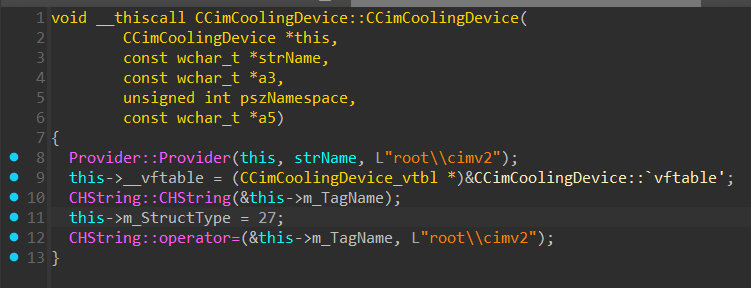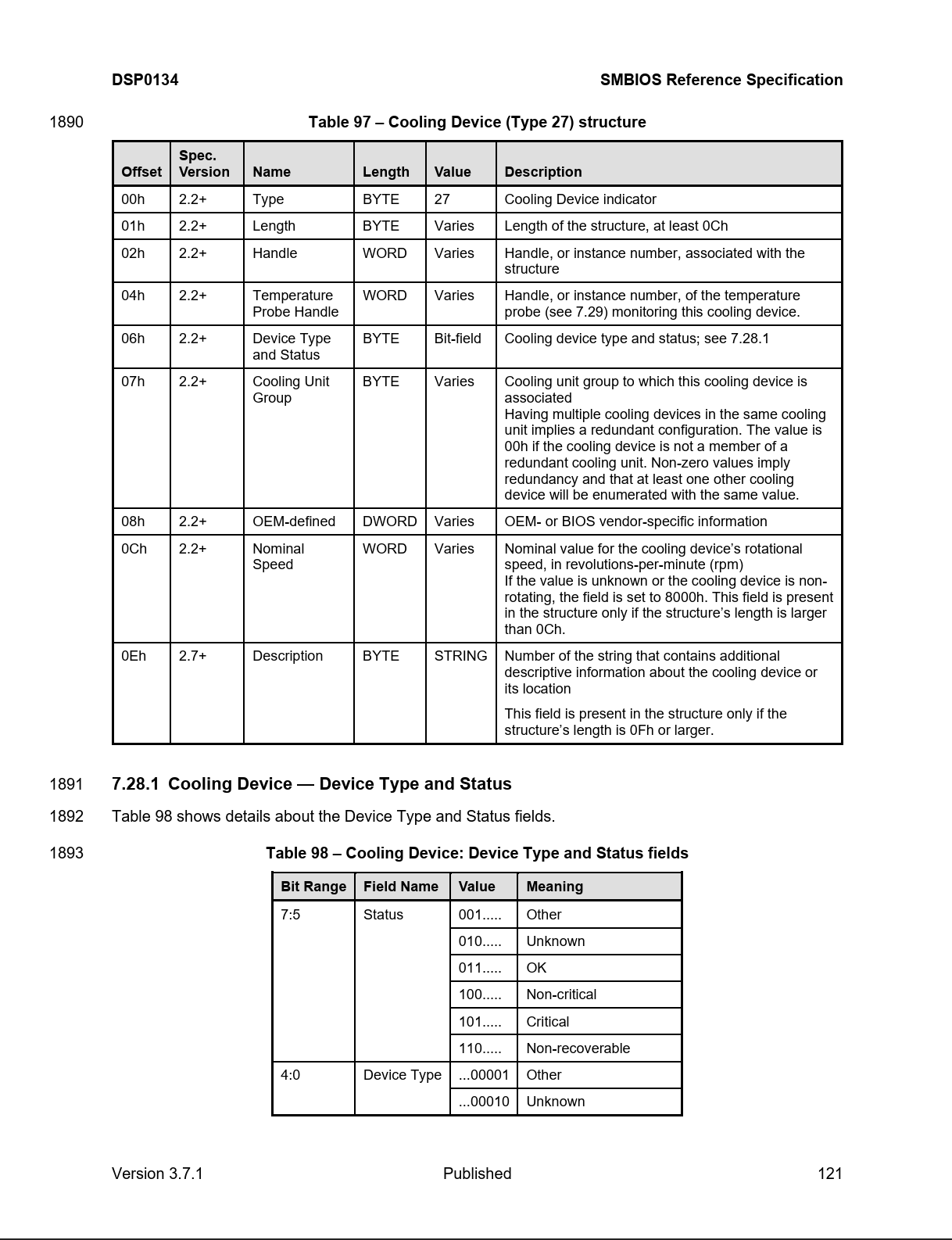Why bother?
Some malware samples are known to do various checks to determine if they are
running in a virtual machine. One of the common checks is to look for
the presence of certain hardware components that are typically not emulated
in virtualized environments. One such component is the CPU fan.
One of the observed ways malware checks for the presence of a CPU fan is by
looking for the Win32_Fan class in WMI:
wmic path Win32_Fan get *
And the reason they do this is they want to avoid running in virtual machines, because they want to complicate the analysis process for security researchers.
There are plenty of ways for malware to detect if it is running in a VM.
In fact, there are plenty of WMI classes that can reveal the presence of
virtual hardware, such as Win32_CacheMemory, Win32_VoltageProbe, and
many others.
In this post, I will be focusing on the CPU fan. Just because I like the idea making a virtual machine think it has it. However, the same approach can be applied to other hardware components and WMI classes as well.
How the computer knows it has a CPU fan?
The computer knows it has a CPU fan by reading the SMBIOS data.
How do I know that? By googling.
Win32_Faninstances are provided byWindows\System32\wbem\cimwin32.dll. If you disassemble it you will see that it reads SMBIOS data (specifically entries with type 27) to get fan device information.
And indeed, if you disassemble cimwin32.dll, you will find exactly that:

Your first impulse might be to use DLL hooking and patch the cimwin32.
But that’s detectable. We can do better.
Type 27
The SMBIOS type 27 is defined as “Cooling Device” in the System Management BIOS Reference Specification:

We can dump the SMBIOS data using the dmidecode utility:
root@host:/# dmidecode -t27 -u
# dmidecode 3.3
Getting SMBIOS data from sysfs.
SMBIOS 3.4 present.
Handle 0x1B00, DMI type 27, 15 bytes
Header and Data:
1B 0F 00 1B 00 1C 65 00 00 DD 00 00 E0 15 01
Strings:
43 50 55 20 46 61 6E 00
CPU Fan
By default, the dmidecode utility will interpret the data and display it in a
more human-readable format:
root@host:/# dmidecode -t27
# dmidecode 3.3
Getting SMBIOS data from sysfs.
SMBIOS 3.4 present.
Handle 0x1B00, DMI type 27, 15 bytes
Cooling Device
Temperature Probe Handle: 0x1C00
Type: Chip Fan
Status: OK
OEM-specific Information: 0x0000DD00
Nominal Speed: 5600 rpm
Description: CPU Fan
Setting custom SMBIOS data in Xen
At the time of writing, the only available resource I found on how to set custom SMBIOS data in Xen is this almost 10 years old mcnewton’s post. I recommend reading it, as it exactly describes the struggle I had when figuring this out.
In short, you can set custom SMBIOS data in Xen by setting the smbios_firmware
option in the domain configuration file to the path to a file containing
the SMBIOS data.
So, let’s create a file named smbios.bin with the following byte content:
1B 0F 00 1B 00 1C 65 00 00 DD 00 00 E0 15 01 43 50 55 20 46 61 6E 00 00
Note that the content is same as the output of dmidecode -t27 -u above,
but with additional 00 byte at the end, because the SMBIOS specification
requires it.
In the Xen domain configuration file documentation, we can also find this:
Since SMBIOS structures do not present their overall size, each entry in the file must be preceded by a 32b integer indicating the size of the following structure.
Our structure is 24 bytes long, so we need to prepend the content with
18 00 00 00 (24 in little-endian):
18 00 00 00 1B 0F 00 1B 00 1C 65 00 00 DD 00 00 E0 15 01 43 50 55 20 46 61 6E 00 00
Now we can set the smbios_firmware option in the Xen domain configuration file
to the path to this file:
smbios_firmware = "/path/to/smbios.bin"
Let’s save the configuration file and start our Windows domain.
root@host:/# xl create /path/to/windows/domain.cfg
And let’s check if the CPU fan is now present in the Windows VM:
PS C:\> wmic path Win32_Fan get *
No Instance(s) Available.
Oh noes. Something’s wrong.
The Betrayal
I missed one important detail in the documentation of the smbios_firmware option:
smbios_firmware=”STRING”
Specifies a path to a file that contains extra SMBIOS firmware … Not all predefined structures can be overridden, only the following types: 0, 1, 2, 3, 11, 22, 39. The file can also …
Frankly, I did not miss this at first. I just hoped that what I was trying to do was not “overriding” the predefined structure.
Because Xen (or rather hvmloader) does not define it.
So, before defining it myself, I tried to find out if there was any other poor soul who tried to do the same thing before me. And to my disappointment, there was. Right in the xen-devel patch archive.
Why it was my disappointment, you may ask? Because after reading the response to the patch, I felt the frustration of the author. But that’s for another story.
Anyway, the patch was rejected, but it’s small and simple, so it’s easy to apply it to the Xen source code.
Type 28, too
After applying the patch and recompiling Xen, I was still getting
No Instance(s) Available error when trying to query the Win32_Fan class.
It didn’t make sense to me, so I dumped the SMBIOS data from the VM, to check
whether the type 27 was present (dmidecode is available on Windows, too!):
PS C:\> .\dmidecode -t27
# dmidecode 3.5
SMBIOS 2.4 present.
Handle 0x1B00, DMI type 27, 15 bytes
Cooling Device
Temperature Probe Handle: 0x1C00
Type: Chip Fan
Status: OK
OEM-specific Information: 0x0000DD00
Nominal Speed: 5600 rpm
Description: CPU Fan
It was there! But why was it not showing up in WMI? I noticed this line:
Temperature Probe Handle: 0x1C00
This line indicates that the cooling device (CPU fan) is associated with a temperature probe, which is another SMBIOS type (type 28). However, the temperature probe was not defined in the SMBIOS data:
PS C:\> .\dmidecode -t28
# dmidecode 3.5
SMBIOS 2.4 present.
That’s it.
One more table to fake.
So let’s shut down the VM and dump the type 28 data from the host:
root@host:/# dmidecode -t28
# dmidecode 3.3
Getting SMBIOS data from sysfs.
SMBIOS 3.4 present.
Handle 0x1C00, DMI type 28, 22 bytes
Temperature Probe
Description: CPU Thermal Probe
Location: Processor
Status: OK
Maximum Value: 0.0 deg C
Minimum Value: 0.0 deg C
Resolution: 0.000 deg C
Tolerance: 0.0 deg C
Accuracy: 0.00%
OEM-specific Information: 0x0000DC00
Nominal Value: 0.0 deg C
And again, the byte representation:
root@host:/# dmidecode -t28 -u
# dmidecode 3.3
Getting SMBIOS data from sysfs.
SMBIOS 3.4 present.
Handle 0x1C00, DMI type 28, 22 bytes
Header and Data:
1C 16 00 1C 01 63 00 00 00 00 00 00 00 00 00 00
00 DC 00 00 00 00
Strings:
43 50 55 20 54 68 65 72 6D 61 6C 20 50 72 6F 62
65 00
CPU Thermal Probe
Therefore, this is the content we need to append to our smbios.bin file
(again, mind the extra 00 byte at the end):
1C 16 00 1C 01 63 00 00 00 00 00 00 00 00 00 00 00 DC 00 00 00 00 43 50 55 20 54 68 65 72 6D 61 6C 20 50 72 6F 62 65 00 00
Oh right! We need to prepend the size of the structure, which is 41 bytes this time (0x29 in hex):
29 00 00 00 1C 16 00 1C 01 63 00 00 00 00 00 00 00 00 00 00 00 DC 00 00 00 00 43 50 55 20 54 68 65 72 6D 61 6C 20 50 72 6F 62 65 00 00
So, the final content of our smbios.bin file should look like this:
18 00 00 00 1B 0F 00 1B 00 1C 65 00 00 DD 00 00 E0 15 01 43 50 55 20 46 61 6E 00 00 29 00 00 00 1C 16 00 1C 01 63 00 00 00 00 00 00 00 00 00 00 00 DC 00 00 00 00 43 50 55 20 54 68 65 72 6D 61 6C 20 50 72 6F 62 65 00 00
Xth Time’s the Charm
Let’s save the file and start our Windows domain again:
root@host:/# xl create /path/to/windows/domain.cfg
And let’s check if the CPU fan is now present in the Windows VM:
PS C:\> wmic path Win32_Fan get Description,Status
Description Status
Cooling Device OK
Yay! The VM now thinks it has a CPU fan!
If you’re wondering why I didn’t use * in the wmic command, it’s because
the Win32_Fan class has *many* properties, and I wanted to keep the output
short and sweet. wmic path Win32_Fan get * would work just as well.
Setting custom SMBIOS data in QEMU/KVM
If you’re using QEMU/KVM instead of Xen, your life is much easier. You don’t
need to patch anything. You can set custom SMBIOS data using the -smbios
option:
qemu-system-x86_64 ... -smbios file=/path/to/smbios.bin
Or, if you’re using libvirt:
<qemu:commandline>
<qemu:arg value='-smbios'/>
<qemu:arg value='file=/path/to/smbios.bin'/>
</qemu:commandline>
However! Remember how Xen required those 32-bit integers indicating the structure sizes? QEMU does not require them, so you can just use the raw data without prepending the size:
1B 0F 00 1B 00 1C 65 00 00 DD 00 00 E0 15 01 43
50 55 20 46 61 6E 00 00 1C 16 00 1C 01 63 00 00
00 00 00 00 00 00 00 00 00 DC 00 00 00 00 43 50
55 20 54 68 65 72 6D 61 6C 20 50 72 6F 62 65 00
00
That’s it! QEMU will automatically handle rest of the important SMBIOS entries for you.
However, if you’re wondering whether you could just take the host’s SMBIOS data and use it in the VM, the answer is yes. You can try that on your own:
cat /sys/firmware/dmi/tables/DMI > /path/to/smbios.bin
References
-
Xen domain configuration file syntax:
https://xenbits.xen.org/docs/unstable/man/xl.cfg.5.html -
mcnewton’s notes - Setting custom SMBIOS data in Xen DomUs:
https://notes.asd.me.uk/2015/12/04/setting-custom-smbios-data-in-xen-domus/ -
[XEN PATCH] tools/firmware/hvmloader/smbios.c: Add new SMBIOS tables (7,8,9,26,27,28):
https://old-list-archives.xen.org/archives/html/xen-devel/2022-01/msg00725.html -
System Management BIOS Reference Specification:
https://www.dmtf.org/sites/default/files/standards/documents/DSP0134_3.7.1.pdf -
QEMU Anti Detection patches:
https://github.com/zhaodice/qemu-anti-detection